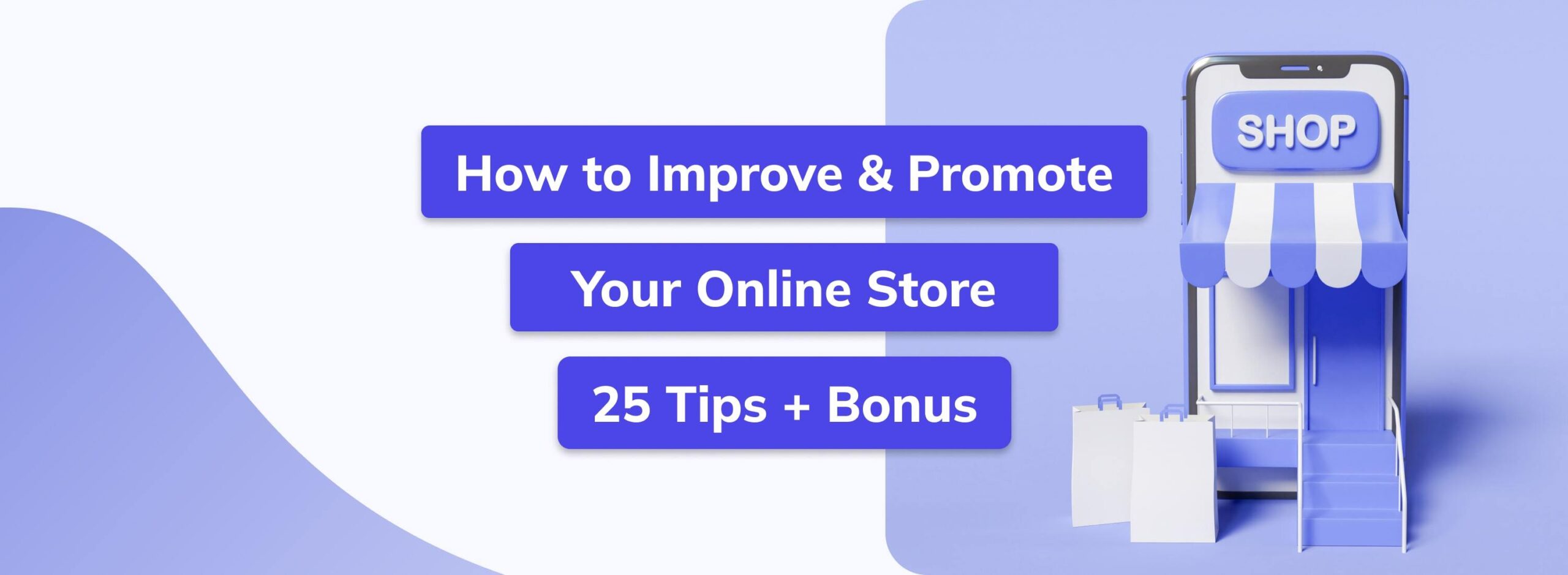What are the main features of creating and promoting an online store? First of all, an online store is a large (sometimes even extremely large) site. This site may have several thousand products, which automatically excludes an individual approach to the creative optimization of each page of your online store. Moreover, taking into account the active influence of users’ behavior on a website on positions in search results, it is necessary to use all the usability rules in the development of your online store as much as possible.
In this article, we will not only look at the specifics of online store SEO, but also define the general optimization and usability rules for eCommerce projects.
No time to waste, let’s get straight to the tips for optimizing the online store.
Onpage optimization and content
1. Choose the right keywords
The basis of good promotion of the online store—quality work with the semantic core of the site.
So you need to:
- Work through the entire list of interesting and potentially selling search queries. It is important to remember that quality is better than quantity.
- Choose the low-frequency and targeted queries, such as “hire a good PHP-developer from India” (of course, if you really are willing to offer a nice web developer for hire).
- Allocate queries to all useful pages of your site so you don’t miss some potential traffic.
Well, you need to determine keyword difficulty, search volume, and user intent in order to know which keys to use.
Using Google Ads Keyword Planner, you can determine the approximate search volume and intent (what exactly your customers wanted to find).
If you have competitors who rank higher in search results than you do, you can use their sites to find keyword ideas. First, type your keyword into a search engine, select a competitor, and scan their website and product pages for potential keywords.
It is crucial to keep in mind that you shouldn’t just use the same keyword as your competitors simply because they are higher in rank. Analyze thoughtfully, figuring out how well your competitors’ keywords match the assortment of your site. If a competitor is active in the area of “web developers from USA”, and your developers are from India only, it’s probably better to prefer more relevant terms.
Try to find out the user intent (search intent). Search intent is the goal that the user pursues when surfing the Internet. For an online store, the correct user intent would be to make a purchase. For example, someone browsing “average tea store income” might be looking for information about starting their own company. But a user looking for “a tea store with fast delivery” probably wants to buy something right now. Of course, the best strategy would be to focus on keywords that are more likely to lead to a purchase (transactional queries).
By the way, the semantic core of the site will allow you to create an optimal catalog structure and filter system—knowing the popularity of search queries on the web, you can understand how to present the goods on your own site.
2. Use “long-tail” keywords
A long-tail keyword is a term that usually refers to a query with low search volume, but meets the relevancy criteria for your business. Such queries tend to convert well into sales by fully matching the answer to the potential user intent.
For these reasons, you shouldn’t be afraid to use long-tail keywords, as they are a valuable source of sales traffic.
An example of a keyword with a long-tail is the query “hire the best freelance PHP Developers in Sri Lanka”.
Thus,”long-tail keywords are great for:
- competitive niches
- increase in conversion rate
- improving the ranking of new sites
3. Implement automatic generation of meta tags
Meta tags play a key role in promotion. Indeed, thanks to meta tags, search robots understand what the site pages are about. But for all the pages of large online stores with a huge number of products it’s complicated to prescribe titles, descriptions, and h1 manually. To simplify these types of pages, we propose to make a convenient autogeneration formula and ask the programmer to breathe life into it. For example,
Title = A +B+C+D — General title, where
A = Buy, order, select, purchase, etc.
B = product name
C = brand
D = Online store, website
General title = General website title
As a result, the title of the individual product card will be automatically displayed in this style: “Buy Pittsburgh Penguins sweatshirt in the online store — Fan Equipment Site.ru”.
4. Fill product cards with unique texts
There are no options here, because search engines do not accept “stolen” content. Descriptions for product cards, if you want (and you should want) to collect low-frequency traffic for product names, must be strictly unique.
In an ideal world, every product page should have more information than just “price, photo and title.” It should also contain a detailed description that “sells” the product—to both buyers and search engines.
Think about what information potential customers would find useful. Then create a handy text template for the copywriter in the product card, like “What are we selling? Why should my customers buy it? Benefits. The best features.” If you keep the product descriptions similar, it will be easier for users to choose the right one and make a purchase on the site.
5. Optimize the alternative text of images
Search engines can’t really “see” your images. So how do they know what’s in each picture? Alternate text.
Alternate text is essentially the caption you add to each image on your site, and it should contain your target keyword and be as descriptive as possible. The second part of the work is crucial: your goal should be to describe your image in a way that can be understood by someone who can’t see it at all. Why? Because alternative text is also used by screen readers to “read” images to people with visual impairments.
So, if you can include a target keyword in the alt tag, great!
Use the alt tag, which will tell search engines what’s shown in the picture. Also, make sure that the PHP Developer photo file is named php-developer.png, not hwvgedVGWwn222.png. Search engines will be very happy with this.
6. Enable LSI Copywriting
LSI keywords are additional key queries that are closely related to your main keyword. Search engines consider them semantically associated with the topic.
For example, the main query “holiday in Egypt” LSI-queries will be “last minute travel deals, travel, price, the Red Sea”. And in your SEO-text you need to use not only the keyword query, but also the LSI-queries you have chosen:
We offer you to go on a delightful holiday in Egypt. Check out our section last minute travel deals to find the best option. Travel prices will pleasantly surprise you. Go to the Red Sea tomorrow!
You can find LSI-queries by using good old-fashioned Google Ads Keyword Planner, which we talked about above.
7. Think carefully about internal linking
It’s not just the weight of the page that matters here (how the weight will be transferred—from goods to top-level categories or vice versa), but also the correspondence of the links to the user’s path through the site you’ve thought out. For example, if the user has already reached the product card, he should have one exit—the cart. And there are no options for returning.
The longer you can keep visitors browsing your online content, the better chance you have of making a sale. Relevant links to other landing pages on your site help your potential customers browse and find the information or products they want.
Internal links can be used to attract customers to relevant product pages, category pages, and educational content.
However, make sure you don’t get too carried away with internal links. One or two links for every few hundred words is enough.
8. Track down and destroy duplicates
Duplicate content on the site traditionally interferes with correct indexing and sustainability of the site in the top search engines for important keywords.
Block it by disallowing indexing (robots.txt) or by indicating the main page with this content (rel=”canonical” link element).
Canonical URLs help your website by telling Google which version of the URL should appear in search results.
9. Set up easy-to-recognize page addresses for visitors
Human-Readable URLs like site.ru/catalog/gifts/children/teddy-bears look much better than site.ru/76372-id?-726371221.
10. Place social media icons in product cards
Additional natural links to your site from social media and blogs will be a beneficial addition to the overall promotion strategy of your online store.
Put a social sharing plugin in the product cards, so that users can easily and quickly send a link to your content to their social networks.
11. Add product reviews
In addition to being a powerful tool for increasing conversions and building site credibility, product reviews can help improve your product pages from a SEO perspective.
By adding customer-written reviews to your pages, you can increase the amount of text on your page and potentially include more LSI keywords. If you prefer full control over the content on your product pages, you can always collect reviews privately via email and manually select the ones you want to showcase.
12. Use content marketing widely
Content is an important part of today’s marketing strategy.
Quality conten+t is one of the easiest ways to improve search engine rankings for a large number of keywords and get great backlinks.
Again, you have limited product and category pages. And at some point, you’ll hit an optimization ceiling—you’ll need new pages for SEO.
Content can help fill those gaps.
There are many types of content you can focus on:
- answers to frequently asked questions
- instructions and practical tips
- company and industry news
- glossary, dictionary of terms
- user-generated content (UGC)
- customer reviews
- videos
- webinars
Technical SEO and website usability
13. Optimize your contact information page
Be sure to include your company address and a clear map showing the location of your company. To do this, you can use schema.org-based microdata—specially trained search engine robots recognize the markup, which allows them to display the information in a user-friendly way.
14. Create a “Payment and Shipping” page
Visitors should be able to quickly and easily find out what methods of payment are available and when your couriers can deliver it to their door.
15. Think about the structure of the site in detail
The organization of the structure of the site is worth worrying about even at the stage of developing an online store. What is important to you? To sell the user a product, and preferably more than one. What is important to the user? To find the right product fast. Therefore categorize your entire array of products and think about how the user would search for items by category. Your job is to make the potential customer’s path simple and beautiful.
Essentially, it’s about giving customers the best, most relevant content and reducing the number of clicks users have to make to find it.
There are two “golden rules” of great website structure:
- Make it straightforward and scalable.
- No page should require more than three clicks to go from any other page.
Use keyword research to create relevant URLs for pages and subs.
For example, if you see that customers are interested in the queries “black coats”, “wool coats”, “winter coats” in the “Coats” topic, you can create the following subcategory/filter structure:
Coats:
- Colors
- Materials
- Season
Etc.
16. Connect filter system and/or advanced search
It won ‘t be enough to have categories only. If the visitor is looking for a short skirt, she is most likely ready to go to the right category (Women’s Wear – Skirts – Mini Skirts) and check out the selection. That’s convenient, of course, but if she wants to buy a yellow leather miniskirt in size M, why make her look through 15 pages of every possible miniskirt from your product range? Use filters. Give her the opportunity to identify the color she wants (yellow), the size (M), and the material (leather). A customer who finds the right product promptly, would not leave without a purchase and would definitely come back.
17. Add a convenient product comparison system
That’s especially relevant for online stores that sell appliances or tools. The ability to compare two similar models in a table of characteristics will help the visitor turn into a customer. And maybe save the time of your sales staff.
18. Add “trust” indicators to the site
Place a nice “Support” page on the site with customer service contacts and add company history with photos of the office, top managers of the online store. Don’t forget to add prominent links in the bottom of the site to the terms of privacy policy, agreements of offer, page reviews of the store. Also necessary in the product cards are quality certificates or confirmation that you are the official dealer of the manufacturer.
19. Make sure that the ordering system works correctly
Check the online ordering system. Check again. In all possible browsers. Ask your grandmother (don’t help her!) and younger brother to order online. Observe the “victims” as they create the order: what challenges do they encounter along the way? Do they understand how to fill out a certain field? If there are any difficulties—simplify it. And give visitors a quick order option (yes, many people hate huge forms, let them just order!). Don’t forget to try placing an order on the site from your smartphone—it might amuse you to try. By the way…
20. Use adaptive layout
You can also make separate “mobile and tablet” versions of the site for different devices, but for a simple online store it will be more convenient to provide the ability to use the site on different devices. Adaptive layout will help your site feel comfortable on a tablet screen as well as on a simple android smartphone.
It should be an integral part of any SEO strategy for an online store. Why? People love to shop from the comfort of their couch using their smartphones.
It’s recommended that you carefully review each of your web pages on your own and other people’s phones (and definitely in different browsers with different operating systems—iOs and Android) to make sure your site is fully adaptive.
21. Highlight the “best” products
Use blocks like “Bestseller” or “Best Price” to highlight interesting items on your site. Just don’t turn these blocks into a “marketing tool”. Be adequate, if you have a few boxes of expensive greenhouses in your warehouse, no user will believe that this particular product was the real sales hit of the frosty autumn.
22. Take care of “dead” product cards
If you are thinking about optimizing an online store with a huge variety of products, and you are concerned about your customers (and managers) enough to warn them in time about the unavailability of certain goods, you will definitely face the question of “dead items”.
You have two options. If the product is temporarily out of stock, leave the product card in place,
- by inviting users to subscribe to information on the appearance of products in the range (with notification by email or sms);
- highlighting in the product card the expected date of arrival;
- showing similar items to the user.
If the product is no longer available, and you have no intention of returning it to the stock, assign a 404 response code to this card.
23. And make sure you have a awesome “404” page
It should be interesting (to neutralize the negative emotions of the user) and useful (so that the user does not leave the site, and see where to look for the right product). Pretty girls, cats and smiling babies are acceptable!
24. Check the loading speed of the site
Nothing is as annoying to a potential customer as a slow site. The desire to shop in this case will evaporate with every extra second of loading.
Site speed is important not only for users, but also for search engines.
To get an idea of what you can do to speed up your site, go to Google’s PageSpeed Insights tool and check your web resource. Google will score you on a 100-point scale and give you instructions on how to make your site load faster.
25. And finally, use Schema Markups microdata
Microdata are HTML tags that provide additional information about the content of web pages. Using this kind of layout, you can improve the SEO of your online store.
It also helps people find what they are looking for faster and easier by showing different types of information.
The main types of micro markup for an online store:
- Product: an extension for products, services and businesses. It allows you to find new products and services in online searches by providing complete product information such as images, price and availability. The Product schema also allows you to display product listings in search results.
- Review: allows you to show reviews to searchers.
- Video: type of metadata used to describe the video content and format. For example, the video schema might include the audio language, video resolution, or age rating.
- Price: is a method of indicating the prices of products.
BONUS: Marketing Tactics to Promote Your Online Store: what’s next?
In addition to the results of SEO we recommend you to attract and concentrate high-quality traffic through all available and accessible means.
The available methods include the following:
- PPC advertising
- Tenders
- Marketplace ads
- Affiliate programs
- Mailings
- Offline events for supporting an online brand
Never stop on the first option, combine it, and always use ROI to measure the success of each communication channel.
If your customers love your online store, website promotion will be an easy and pleasant task. After all, the marketing of an online store will be handled not only by you, but also by thousands of your satisfied customers.







